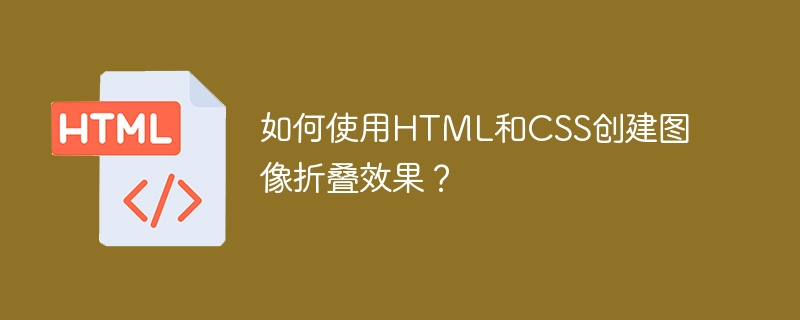

In today’s digital age, creating visually appealing and interactive user interfaces has become an important aspect of web design. One of the popular effects used in modern websites is the image fold effect. This effect provides a unique and engaging way to display images on your website. The art of image folding effects can be created through the application of HTML and CSS, which are fundamental building blocks of contemporary digital architecture. In this post, we’ll guide you through building an image fold result piece by piece using HTML and CSS. After reading this article, you will have a solid understanding of how to achieve this effect and make your website stand out.
The transform property in CSS is used to make changes to the shape, position, or size of HTML elements. It allows software engineers to change the arrangement, rotation, twist, size and other optical characteristics of components. Transformation is accomplished with the assistance of 2D and 3D deformation operations such as transfer, rotation, tilt, and amplitude. Transition properties work seamlessly with all latest web browsers and can be used to generate dynamic and animated visual components that trigger user engagement and interaction. The transformed component maintains its inherent size, contour, and position, and other adjacent components adapt to the transformed component. This is a great way to work with elements on a web page without affecting the layout of other elements on the page.
transform: [function] [value];
Function can be any of the following&miinus;
translate() - Moves an element along the x and y axes.
rotate() - Rotates an element around its origin.
scale() - Increase or decrease the size of an element.
skew() - Twists an element along the x or y axis.
matrix() - Combines multiple transformations into a single transformation.
Value depends on the specific function you are using. As an illustration, if you choose to apply the translate() function, this value can be expressed as translate(x, y), where the numerical values of x and y represent the number of pixels needed to move the element in its direction. Horizontal axis and vertical axis.
The CSS selector called :nth-child is used to select elements based on their ordinal position among ancestor elements. It enables you to pinpoint a specific juvenile component contained in an ascending component and attach stylistic attributes to that juvenile component. The :nth-child identifier uses an algorithm to determine which child components should be selected. For example, you can use :nth-child(2) to pick subsequent child elements of a parent element, or :nth-child(even) to pick all successors occupying even slots. < /p>
:nth-child(an+b)
Where a and b are integers, n is a positive integer (starting from 1).
To create an image fold effect for an image, we first need to divide the image into different parts. We will use
The following code is essentially an HTML and CSS program that can be used to create a visually appealing interactive image folding effect. It works through various declarations and directives that, when executed, render images that appear to collapse in a visually engaging and dynamic way. The HTML code begins with a doctype declaration, followed by the opening of the HTML document, the header containing the effects header, and the declaration of the style tag. Next is the body tag, which contains the title and an unordered list of child elements. The list is then styled using CSS to create an effect that involves a container of four child elements, each with a collapse effect.
The CSS code requires a set of instructions that style the unordered list, specifying details such as margins, padding, and positioning of the container. Additionally, it applies a color gradient as the background image for the fold effect. Then specify the size, position, and display properties of the container. Styles also involve the specification of transitions and box shadows, which contribute to the overall effect of the animation.
Additionally, when the user hovers over the container, it applies the skewY() transform property to alternate the container's child elements, creating a dynamic effect that simulates the appearance of an image folded in half. Using the nth-child() attribute helps select alternative child elements to apply the skewY() transformation. In summary, additionally use the nth-child() attribute to specify the background pose of each child component, thereby ensuring accurate configuration of each fragment of the image during the folding process.
Here is the complete code we will look at in this example -
<!DOCTYPE html>
<html>
<head>
<title>How to create Image Folding Effect using HTML and CSS?</title>
<style>
body {
margin: 0;
padding: 0;
}
.container {
margin: 10;
padding: 0;
position: absolute;
top: 50%;
left: 50%;
transform: translate(-50%,-50%);
width: 480px;
height: 270px;
display: flex;
}
.fold {
list-style: none;
width: 25%;
background-image: linear-gradient(yellow,orange,red);;
background-size: cover;
height: 100%;
transition: 0.5s;
}
.container:hover .fold:nth-child(odd) {
transform: skewY(15deg);
box-shadow: inset 20px 0 50px rgba(0,0,0, .5);
}
.container:hover .fold:nth-child(even) {
transform: skewY(-15deg);
box-shadow: inset 20px 0 50px rgba(0,0,0, .5);
}
.container .fold:nth-child(1) {
background-position: 0;
}
.container .fold:nth-child(2) {
background-position: -120px;
}
.container .fold:nth-child(3) {
background-position: -240px;
}
.container .fold:nth-child(4) {
background-position: -360px;
}
</style>
</head>
<body>
<h4>How to create Image Folding Effect using HTML and CSS?</h4>
<ul class="container">
<li class="fold"></li>
<li class="fold"></li>
<li class="fold"></li>
<li class="fold"></li>
</ul>
</body>
</html>
最终,折叠图像印象构成了一个简单但有效的工具,可以将交互性和视觉吸引力融入您的网站。通过遵守本说明中阐述的规定程序,人们可以轻松地使用 HTML 和 CSS 产生这种印象。无论您是新手还是熟练的程序员,本文都为您提供了在网站上实现图像折叠效果所需的知识和材料。通过一点创造力和实验,您可以自定义效果以满足您的特定设计需求并增强访问者的用户体验。所以,今天就开始创建您自己的图像折叠效果吧!
The above is the detailed content of How to create an image fold effect using HTML and CSS?. For more information, please follow other related articles on the PHP Chinese website!